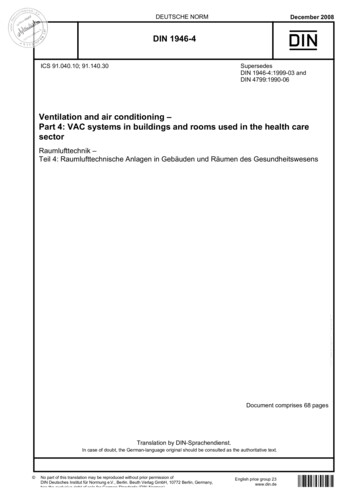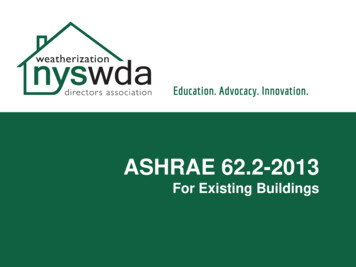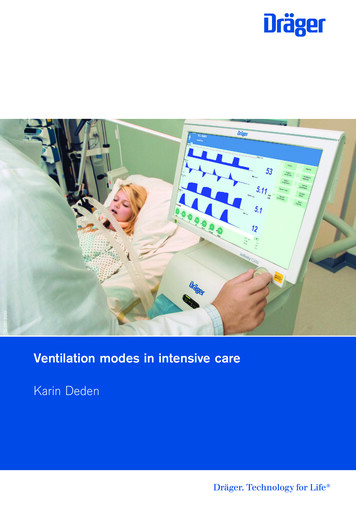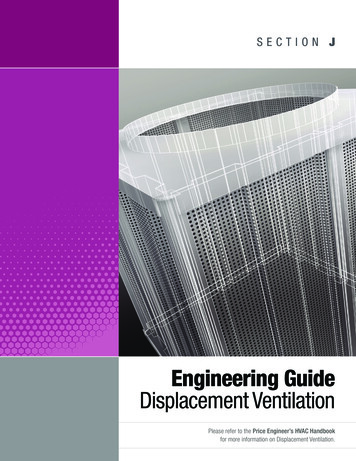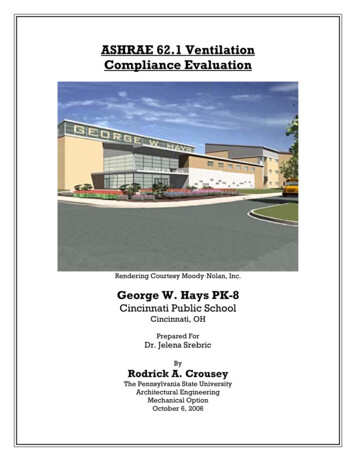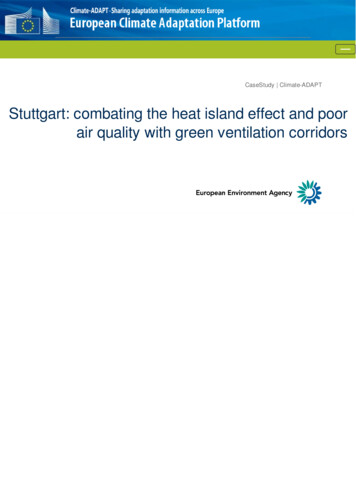
Transcription
CaseStudy Climate-ADAPTStuttgart: combating the heat island effect and poorair quality with green ventilation corridors
Cover design: EEACover photo: EEALayout: EEALegal noticeThe contents of this publication do not necessarily reflect the official opinions of the EuropeanCommission or other institutions of the European Union. Neither the European Environment Agency norany person or company acting on behalf of the Agency is responsible for the use that may be made of theinformation contained in this report.Copyright notice European Environment Agency, 2016Reproduction is authorised, provided the source is acknowledged, save where otherwise stated.Information about the European Union is available on the Internet. It can be accessed through theEuropa server (www.europa.eu).Electronic publication noticeThis report has been generated automagically by the EEA Web content management system on 26 Nov2016, 09:53 AM.This report is available as a website at rs.Go online to get more interactive facts and figures.On the report web page you may download the electronic publication (EPUB) for easy reading on yourpreferred eBook reader.Please consider the environment before printing.European Environment AgencyKongens Nytorv 61050 Copenhagen KDenmarkTel.: 45 33 36 71 00Fax: 45 33 36 71 99Web: eea.europa.euEnquiries: eea.europa.eu/enquiries
ContentsCase studies2Stuttgart: combating the heat island effect and poor air quality with greenventilation corridors (2014)2Case Study Description3Additional Details5Reference Information8Case studies Documents (1)9Keywords9Sectors9Climate impacts9Governance level10Geographic characterization10
Case studiesStuttgart: combating theheat island effect andpoor air quality withgreen ventilationcorridors (2014)Stuttgart’s location in a valley basin, its mild climate, low wind speeds,industrial activity and high volume of traffic has made it susceptible topoor air quality. Development on the valley slopes has prevented air frommoving through the city, which worsens the air quality and contributes tothe urban heat island effect. A Climate Atlas was developed for theStuttgart region, presenting the distribution of temperature and cold airflows according to the city’s topography and land use. Based on thisinformation, a number of planning and zoning regulations arerecommended that also aim to preserve and increase open space indensely built-up areas.Case Study DescriptionChallengesObjectivesAdaptation Options Implemented In This CaseSolutions2Case studies
Importance and Relevance of AdaptationAdditional DetailsStakeholder ParticipationSuccess and Limiting FactorsCosts and BenefitsLegal AspectsReference InformationContactWebsitesSourceCase Study DescriptionChallengesThe city's location has a significant influence on its local climate includingimplications for solar radiation, air temperature, humidity, precipitation andwind. Stuttgart sits in the wide Neckar basin formed by two river valleys,shielded by steep hill slopes. Stuttgart's centre is located at about 240mabove sea level, while the surrounding hills rise to 500m a.s.l.Stuttgart has a mild, temperate climate with warm summers. Wind speedsthroughout the city are generally low, which along with the urban heatisland effect, contributes to poor air quality. The future climate projectionsfor 2071-2100 suggest a 2ºC increase of mean annual temperature inStuttgart. The projections for heat waves (T 30 C) suggest that thenumber of days with heat stress (when people’s thermoregulation isimpaired) will increase significantly. By 2100, 57% of the Greater Stuttgartregion could have more than 30 days with heat stress (in the low lyingareas over 60 days). Therefore, a significantly higher percentage of peopleare likely to be exposed to the risks associated with heat waves than atpresent.ObjectivesCase studies3
The primary objective for the region of Stuttgart is to facilitate air exchangein the city, thereby enhancing the potential for cool air flow from the hillstowards the urban areas on the valley floor.Adaptation Options Implemented In This CaseGreen spaces and corridors in urban areasSolutionsThe Climate Atlas for the region of Stuttgart was published in 2008, basedon the previous work in this area carried out by the City of Stuttgart sincethe 1980s and the in-house urban climatology department (in existence inthe City of Stuttgart since 1938). The Climate Atlas provides standardisedclimatic assessments for the 179 towns and municipalities in the Stuttgartregion. The Atlas comprises maps which show regional wind patterns,flows of cold air, air pollution concentrations, and other relevant informationrequired to inform planners on what to do for urban climatic optimizationthat could inform new projects and retrofits. A key element of the Atlas isan area classification based on the role that different locations play in airexchange and cool airflow in the Stuttgart region, based on topography,development density and character, and provision of green space. TheAtlas distinguishes eight categories of areas in this manner, and for eachof them different planning measures and recommendations are provided.In addition to responding to local climate characteristics, the followingprinciples form the basis for the planning recommendations included in the“Climate Booklet for Urban Development Online – Städtebauliche KlimafibelOnline”:Vegetation should be placed to surround developments and larger,connected green spaces should be created or maintained throughoutdeveloped areas to facilitate air exchange;Valleys serve as air delivery corridors and should not be developed;Hillsides should remain undeveloped, especially when developmentexists in valleys, since intensive cold- and fresh-air transport occurshere;4Case studies
Saddle-like topographies serve as air induction corridors and shouldnot be developed;Urban sprawl is to be avoided;All trees growing in the urban core with a trunk circumference of morethan 80 cm at height of 1m are protected with a tree preservationorder.The implementation of the recommendations in the Climate Atlas is carriedout by the Office for Urban Planning and Urban Renewal, supported by theOffice for Environmental Protection. The Section of Urban Climatologywithin the Office for Environmental Protection evaluates the climaticimplications of intended development and larger buildings. As a result ofthe implementation of the recommendations included in the Climate Atlasand Climate Booklet, over 39% of Stuttgart’s surface area has been putunder the protection of nature conservation orders; a record in Germany.As a result of greening actions, greenery covers more than 60% of the city.Stuttgart contains 5,000 hectares of forests and woodland, 65,000 trees inparks and open spaces and 35,000 street trees. 300,000 square meters ofrooftops have been greened and 40 out of 250 kilometres of tram trackshave been grassed (as of 2007). In line with the city development vision,60 hectares of greenfield land previously earmarked for development hasbeen cut from the 2010 land development plan to protect existing greenspace. Targeted interventions such as a building ban in the hills around thetown, and prevention of building projects that might obstruct the ventilationeffect of nocturnal cold-air flows have resulted in preservation andenhancement of air exchange and cool air flows in the city.RelevanceCase mainly developed and implemented because of other policyobjectives, but with significant consideration of CCA aspectsAdditional DetailsStakeholder ParticipationCase studies5
The Climate Atlas 2008 was developed in close collaboration between theVerband Region Stuttgart (the association of regional cities andmunicipalities) and the City of Stuttgart. The Section of Urban Climatologywithin the Office for Environmental Protection of the City of Stuttgartcontributed with its specialist knowledge. The evaluation and processing ofthe data for drawing up of the basic material required to produce the mapswere undertaken by an external specialist consultant.The City of Stuttgart emphasises the importance of public participation ingreening strategies aimed at improving air quality and mitigation of the heatisland effect. This is achieved through different strategies:Since 1986, the City of Stuttgart has provided financial support togreen about 60,000 square meters of roofs.Since 1992, a scheme has been in place for Stuttgart residents toadopt a tree. Today some 182 caretakers have adopted almost 500trees. They are responsible for watering the tree, reporting pestattacks, removing the leaf litter and fallen branches, and protectingthe tree from dog fouling.The Mayor of the City of Stuttgart supports the city greening initiativesaimed at improving air quality and reducing temperatures. The land useplan 2010 for Stuttgart envisages urban development under the slogan“urban – compact – green”. Climate change adaptation and mitigation areboth high on the political agenda locally. The city has had a climate changemitigation strategy since 1997 and a climate change adaptation strategywas developed in 2012.Success and Limiting FactorsThe following factors are highlighted:Compilation of detailed information about the area’s topography,climate and land use allows for precise planning for different areas,which together aim to improve air quality and mitigate the urban heatisland effect.The case demonstrates the advantages to a municipality of having in-6Case studies
house climatic research capacity to provide concrete knowledge oflocal conditions and remedies, as opposed to relying on anunderstanding derived from general principles. Cumulatively, overseveral decades, the city has used its planning and landscapingpowers to engineer an entire system of urban air circulation.Constructive use of existing regulations (e.g. the German BuildingCode) provides a mandate for the implementation of planningrecommendations relating to local climate.Close collaboration between the Office for Environmental Protection(analysis of information, provision of recommendations) and the CityPlanning and Renewal team means that the recommended greeninfrastructure solutions are being implemented through spatialplanning and development control.Costs and BenefitsThe initiative was funded by the City of Stuttgart and the Verband RegionStuttgart. The funds were necessary to generate the climatic data aroundwhich the Climate Atlas is produced.Legal AspectsThe preservation of natural environment in urban areas is principallyguided by the Federal Nature Conservation Act (BNatSchG) and by theNature Conservation Act of the Land of Baden-Württemberg (NatSchG).The Federal Nature Conservation Act prohibits the modification orimpairment of protected green spaces, or changing land use in theseprotected areas. Protected green spaces comprise: green zones insettlement areas, parks, cemeteries, significant gardens, single trees,lines of trees, avenues or groves in settled or under developed areas; andsome plantings and protective wooded areas outside forests. Preservingthe history and culture of the region can also be a reason for protectinggreen spaces.German Building Code from 1960 is an important influence over urbandevelopment. The regulations were revised in 2004, and now requireprecautionary environmental protection in urban zoning and planningCase studies7
practices. § 1 (5) states that urban development planning has to besustainable, integrating social, economic and ecological demands, and alsoassuming responsibility for future generations. Urban development plansmust contribute to the creation of an environment that is fit for humanbeings, that protects natural resources, that contributes to climateprotection, as well as preserving and developing the urban pattern andappearance of the landscape of towns and cities. According to § 1 (6) thefollowing aspects have to be taken into account (amongst others) whenestablishing urban development plans: the presentation of landscape plansand green open space structure plans, as well as other plans concerningissues such as water rights, waste rights and pollution control rights; andthe conservation of the best possible air quality.Reference InformationContactUlrich ReuterMunicipality of StuttgartOffice for Environmental Protection, Department of Urban ClimatologyGaisburgstraße 4, 70182 Stuttgart, GermanyTel: 49 711 216 88625E-mail: klima-stuttgart.de/index.php?climate climate atlas tart eSourceGreen and Blue Space Adaptation for Urban Areas and Eco Towns(GRaBS)8Case studies
Share your informationCase Study Illustrations (4)Case studies Documents (1)Stuttgart climate change challengesKeywordsAir quality, green space, spatial planning, urban heat islandSectorsHealth, UrbanClimate impactsCase studies9
Extreme TemperaturesGovernance levelLocal (e.g. city or municipal level)Geographic characterizationEuropeMacro-Transnational region:North West Europe, Central EuropeBiographical regions:ContinentalCountries:GermanySub Nationals:Stuttgart (DE)City:Stuttgart10Case studies
The City of Stuttgart emphasises the importance of public participation in greening strategies aimed at improving air quality and mitigation of the heat island effect. This is achieved through different strategies: Since 1986, the City of Stuttgart has provided financial support to green about 60,000 square meters of roofs.
